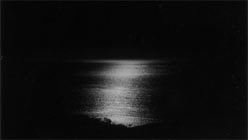Sean McFarland is a rare thing: a photographer with a studio practice. Having long explored unconventional methods in photography, his current show, Viewshed at Baer Ridgway Exhibitions, showcases his range and talent. The show is large, and features two distinct, though interrelated, bodies of work: his extensive Pictures of Earth Polaroid series, as well as his current endeavor, Dark Pictures, begun in 2008. Both groupings picture Western landscape as a thing both alien and cerebral.
The Pictures of Earth Polaroids are the largest grouping, at twenty-three images. The Polaroids depict natural scenes, most often shot from above, ranging from the bucolic (waterfalls and crop fields) to the catastrophic (explosions and tornados). The outdated format evokes nostalgia for the medium as well as the landscapes; the rolling hills are gradually disappearing alongside the light-sensitive emulsion of the instant photographs that picture them. The Polaroids also create a sense of detachment from the viewer; at 3.25 by 4.25 inches, the unique images are too small to be seen clearly, and feel less like photographs than private windows into parallel worlds. And here is the best part, saved for last: While some of these photographs where indeed taken in the field by McFarland, most are images of images — miniature simulacra — taken in the artist’s studio. In McFarland’s work, it makes little difference which is “authentic;” both capture the fiction of a distant American West.

“Creek Portrait,” Sean McFarland, 2011.
McFarland’s most recent body of work, Dark Pictures, is in some sense, anti-Polaroids: large, dark, and detailed images of foliage too dense to see through. Though they might easily be mistaken for unexplored forestry in a national park, the images were actually taken in controlled city parks, gardens and lots within ten miles of McFarland’s Mission District home. These are man-made landscapes, developed for the sake of urban beautification. As in McFarland’s Polaroids of existing photographs, you wouldn’t know it.
While both Pictures of the Earth and Dark Pictures engage an element of fiction, the photographs give away no easy hints of their own construction. There is no trash peeking from behind the dense foliage in Dark Pictures, no trace of the artist’s hand in re-photographing source material for Pictures of the Earth (the explanation is available to the curious viewer, but does not appear alongside the work or in its title). Instead, the images in both series are beautiful and uncanny, and never eclipsed by self-satisfaction in their making.


